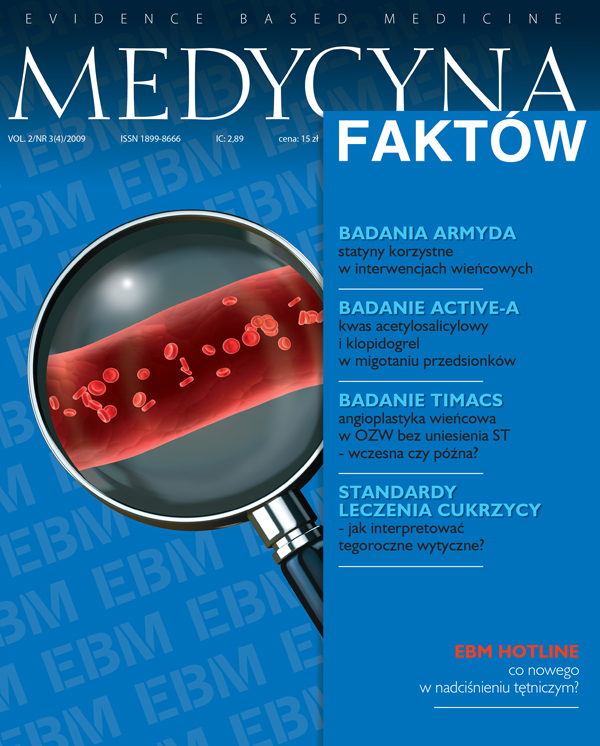Co nowego w nadciśnieniu tętniczym? Artykuł przeglądowy
##plugins.themes.bootstrap3.article.main##
Abstrakt
Nadciśnienie tętnicze oporne staje się kolejnym wyzwaniem dla medycyny i kardiologii. Jak wiadomo, farmakoterapia nie jest metodą terapeutyczną wystarczającą do kontroli ciśnienia w tej grupie chorych. Dlatego coraz częściej sięgamy po metody inwazyjne. W prowadzonych aktualnie badaniach klinicznych zastosowanie stymulacji baroreceptorów zatoki szyjnej przez implantowane podskórnie urządzenie skutecznie obniżało ciśnienie krwi u pacjentów z nadciśnieniem tętniczym opornym. Podobnie ablacja unerwienia współczulnego nerek w obrębie tętnic nerkowych wykonywana przezskórnie prądem RF doprowadziła do istotnej redukcji wartości ciśnienia, utrzymującej się w 12. miesiącu po zabiegu. Obie metody wydają się nie tylko skuteczne, ale i bezpieczne dla pacjentów. Konieczne są jednak duże randomizowane badania kliniczne, aby potwierdzić wspomniane efektywność i bezpieczeństwo.
##plugins.themes.bootstrap3.article.details##
Copyright © by Medical Education. All rights reserved.
Bibliografia
2. Tykarski A., Posadzy-Małaszyńska A., Wyrzykowski B. et al.: Rozpowszechnienie nadciśnienia tętniczego oraz skuteczność jego leczenia u dorosłych mieszkańców naszego kraju. Wyniki programu WOBASZ. Kardiol. Pol. 2005; 63: 614–619.
3. Tykarski A.: Nadciśnienie tętnicze oporne. Choroby Serca i Naczyń 2005; tom 2, nr 4: 190-193.
4. Rojek A., Chrostowska M., Hering D. et al.: Stymulacja baroreceptorów szyjnych jako nowa metoda terapii opornego nadciśnienia tętniczego. Terapia 2008; 7-8: 68-70.
5. Rojek A., Chrostowska M., Narkiewicz K.: Elektryczna stymulacja baroreceptorów zatoki szyjnej w terapii opornego nadciśnienia tętniczego. Kardiologia po Dyplomie 2009; 1: 54-57.
6. Lohmeier T.E., Irwin E.D., Rossing M.A. et al.: Prolonged activation of the baroreflex produces sustained hypertension? Hypertension 2004; 43: 306-311.
7. Lohmeier T.E., Barrett A.M., Irwin E.D.: Prolonged activation of the baroreflex: a viable approach for the treatment of hypertension? Curr. Hypertens. Rep. 2005; 7: 193-198.
8. Głuszek J., Kosicka T.: Nowe możliwości niefarmakologicznego leczenia nadciśnienia tętniczego? Nadciśnienie Tętnicze 2007; 11: 66-73.
9. Scheffers I. et al.: Sustained blood pressure reduction by baroreflex hypertension therapy with a chronically implanted system: 2-year data from the Rheos DEBUT-HT STUDY in patients with resistant hypertension. Journal of Hypertension 2008; 26 (supl. 1): S19.
10. Bisognano J. et. al.: Baroreflex hypertension therapy with a chronically implanted system: Early results from the Rheos Feasibility Trial in patients with resistant hypertension. The Journal of Clinical Hypertension 2006; supl. A 8(No. 4): A43.
11. CRvX [online].
12. DiBona G.F.: Sympathetic nervous system and the kidney in hypertension. Curr. Opin. Nephrol. Hypertens. 2002; 11: 197-200.
13. Krum H. et al.: Catheter-based renal sympathetic denervation for resistant hypertension: a multicentre safety and proof-of-principle cohort study Lancet 2009; 373: 1275-81.
